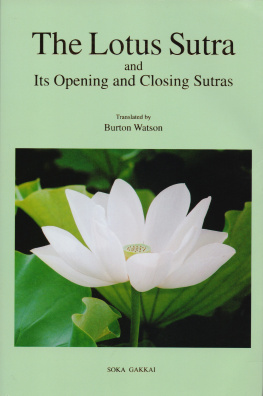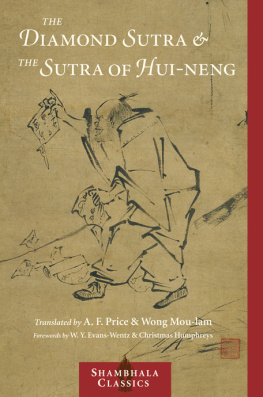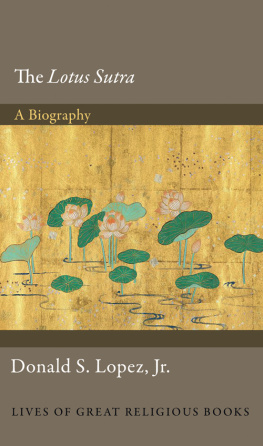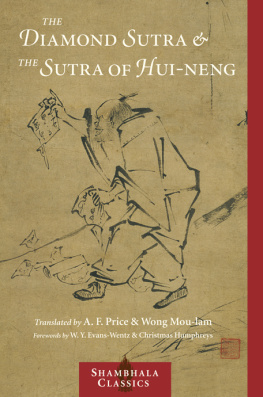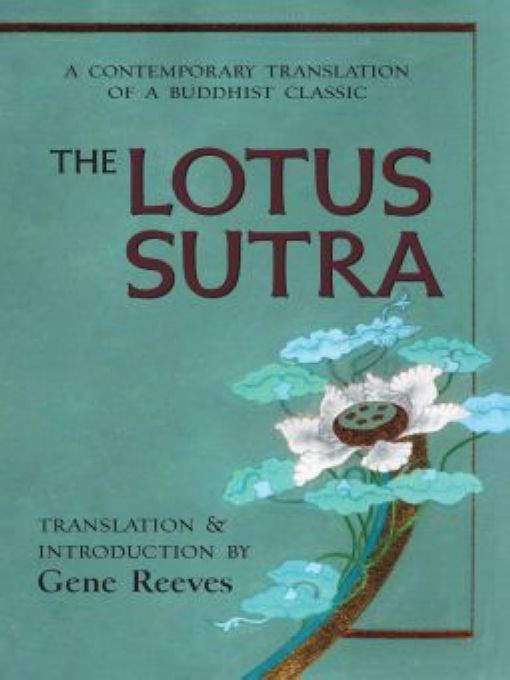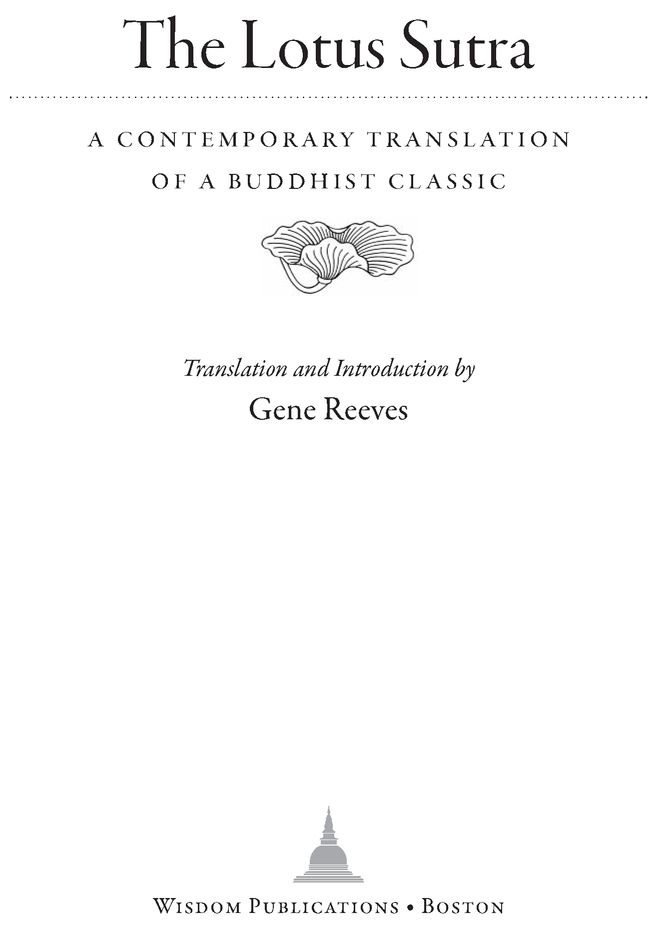Table of Contents
Preface
THIS NEW TRANSLATION of the Lotus Sutra is intended primarily for people who are interested in Buddhism but are not Buddhist scholars. My intention is to provide a highly readable English version of this important text. I want to make this text accessible to ordinary readers with little or no familiarity with technical Buddhist vocabulary. Several other translations are available, some better than others. For scholars interested in comparison of Sanskrit and Chinese versions, for example, the translation by the late Leon Hurvitz will be useful.
While I do my best to make the sutra accessible, I never deliberately compromise the meaning of what I find in it. There are passages in this text that I dont like and wish were not there. There are passages that are extremely difficult if not impossible to understand. There are a great many ambiguities, some intentional, some probably not. My purpose is not to eliminate or soften such passages or to settle the controversies to which they have given rise, but only to provide a version that reveals as much meaning in the sutra as possible.
My first exposure to this sutra was around 1980 when I was invited to participate in a workshop sponsored by the lay Buddhist organization Rissho Kosei-kai, which has its headquarters and the vast majority of its members in Japan. The workshop was designed to enhance interest in the Lotus Sutra among participants, but it had the opposite effect on me. I found a number of things in the text uncongenial. In succeeding years, however, I became increasingly fascinated by this sutra. And I came to think that part of what discouraged me initially was the poor choice of terms in the translation I had read.
Nearly a decade later I decided to move to Japan to study the Lotus Sutra and improve my skills in Japanese and Chinese languages. I was encouraged both by Nikkyo Niwano, the founder and then president of Rissho Kosei-kai, and by Yoshiro Tamura, the foremost Japanese scholar of Tendai thought, who had recently retired from the University of Tokyo and was teaching at Rissho University.
Tamura died within a few months of my moving to Japan, so our several joint projects had to be abandoned. But Tamuras blend of passionate, personal interest in the Lotus Sutra, combined with his profound scholarship and academic rigor, is an inspiration to me still. Nikkyo Niwano, on the other hand, was entirely lacking in scholarly, academic credentials. But he had the same sensibility as Tamura, except that whereas Tamura was primarily an academic and secondarily a follower of the Lotus Sutra, Niwano was primarily a practitioner and devotee of the sutra and secondarily one who studied the scholarship about it. I regard both of these men as my great Dharma teachers, and feel more indebted to them than I can express.
As I became more familiar with Japanese and Chinese versions of this sutra, and despite the fact that some new translations had appeared in print, I became even more convinced that a version for ordinary English-language readers was needed, one that avoided Buddhist jargon and Sanskrit terms as much as possible.
I began dabbling with a translation of my own about a dozen years ago. The first privately printed version was in 2001. Since then there have been many revisions and a few revised versions. Im sure there will be more. Translation of any large and complex Chinese text is not something one can ever expect to get right. All one can hope for is that it will become better.
When Kumarajiva or other translators felt that they could not translate a Sanskrit word into Chinese, they transliterated it; that is, they provided a phonetic equivalent to the Sanskrit. This is one of the reasons why many Sanskrit terms have become familiar in English, terms such as buddha, dharma, stupa, and so on, they are basically transliterations of Sanskrit terms. The normal procedure when translating a Chinese Buddhist text into English is to translate into English what the translator into Chinese translated and use the Sanskrit term if it was only transliterated into Chinese. This works fine, of course, for scholars already familiar with many Sanskrit terms, but less well for others. What I have done in this translation, then, is to translate into English wherever I can; that is, wherever I think there is a reasonably good English equivalent for the term in question.
Sometimes such choices are relatively easy to make. For example, the Sanskrit term kalpa, often left untranslated, is here rendered as eon. Perhaps age would work just as well, but I can see no point in retaining the Sanskrit.
Some choices will be more controversial. The Sanskrit term sangha is often used in English, both in translations and in general use among English-speaking Buddhists, where it has come to mean just about any Buddhist community. For this translation, I have chosen to use monks, since it was often used to translate sangha into Chinese, and monk(s) is what the Chinese character in this sutra literally means. Originally in India and still today in many of the Buddhist worlds of Asia, sangha still refers exclusively to a community of monks. Thus, to use sangha where the text has monks could be confusing or misleading. Where the text intends a larger grouping that includes monks but is not limited to them, I use assembly or, as is often the case in this text, great assembly.
My decision to use the English (originally Greek or Roman) equivalents for most Indian mythological creatures will seem misguided to some. The great Buddhist and Sanskrit scholar Hajime Nakamura was the first to point out to me how closely related these imaginary creatures are. When I saw that Jean-Nol Robert used translations of these terms in his excellent translation of the Lotus Sutra into French, I decided to do the same. The Sanskrit equivalents can be found in the glossary of terms. The one exception to this practice is the term asura, which does not correspond very well with titan and appears in English-language works, translations, and dictionaries. In the case of Dharma I retain the Sanskrit, whereas others have chosen to translate it. Some translators have used law. While I understand that choice, I think it is unfortunate. Sometimes, especially in non-Buddhist Indian usage, dharma does mean something like a regulatory principle, the way things ought to be. In Buddhism generally, the term has several uses, sometimes quite vague. Sometimes, especially in the Universal Sage Sutra translated here, it means something like method. But in the Lotus Sutra the much more fundamental meaning of dharma is teachings, in particular the teachings of the Buddha. Sometimes this same term refers to the fundamental truths that the Buddha realized and taught, as later interpreters have insisted. But even in such cases, the meaning of teachings is always retained or included. In this text, dharma is Buddha-dharma. Given this complexity, I think it is best to retain the Sanskrit term.
Making the situation more complicated, the term dharma in this and other texts has a quite different meaning, which I render as things and for which others have sometimes use phenomena. These things are a consequence of ordinary sense experience; they are what we experience. Such things, of course, are not necessarily physical objects but can be events or even ideas. Fortunately, this use of dharma is almost always readily distinguishable from its use as teaching.


